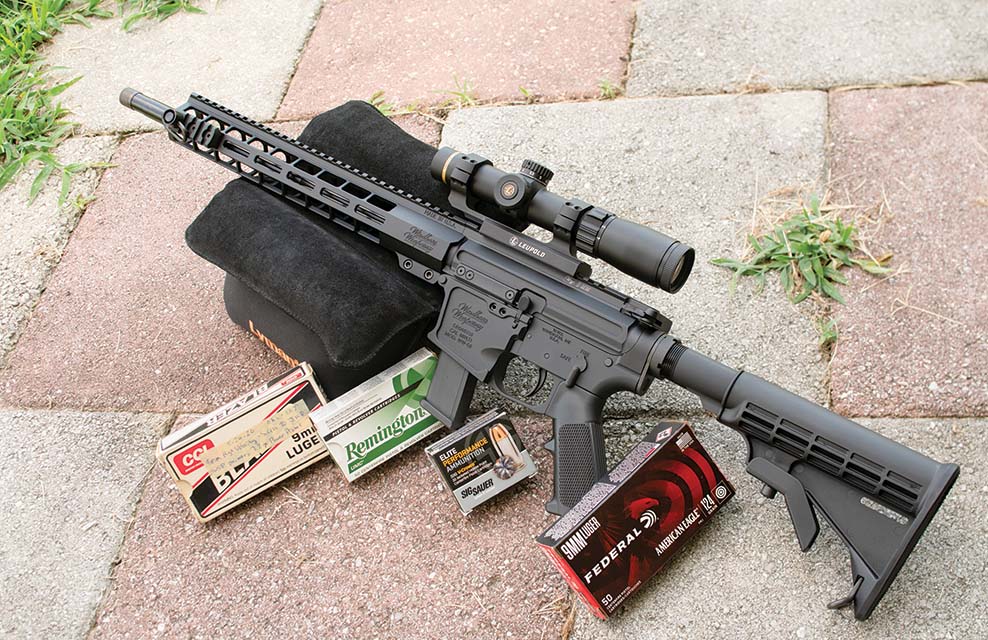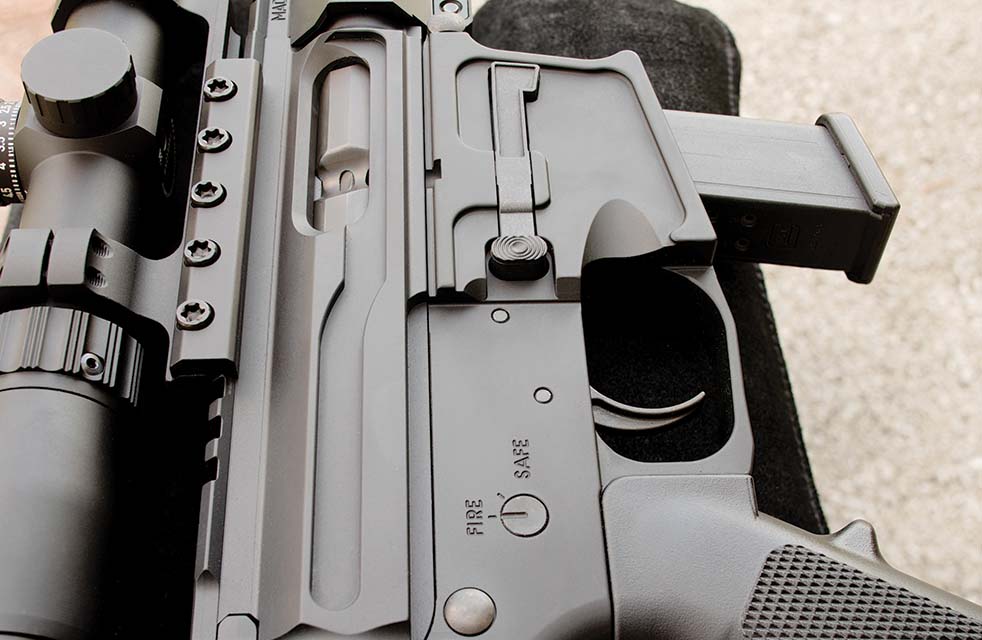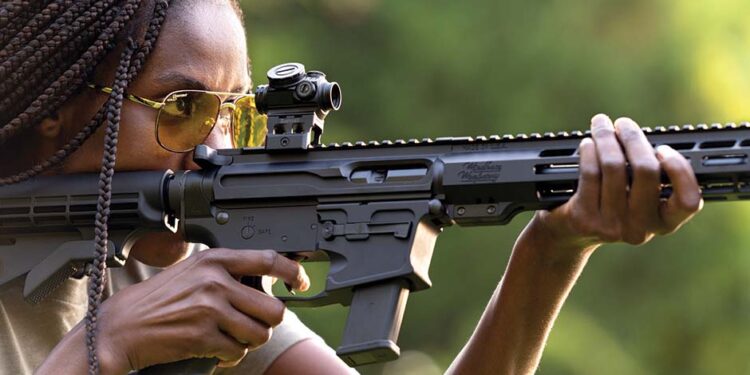Story & Photography by Oleg Volk
While 9mm AR-15-based carbines have been around since the early 1980s, they’ve only hit peak popularity in the last several years. At this point, direct blowback models have been joined by various forms of delayed blowback and locked breech, and the double-stack, double-row-feeding Colt magazines have been eclipsed in popularity by GLOCK-compatible, single-feed magazines. With this vast variety of styles, actions and looks, what sets the Windham Weaponry R16FTT-9mm apart? The answer is in the history of the company that makes it.
Windham Weaponry of Maine originated as Bushmaster around 1976. Famous for its MIL-SPEC AR-15 rifles, this brand was sold and became a part of Freedom Group conglomerate in 2006. The factory was moved out of Maine in 2010 and, eventually, the brand was phased out in 2020. However, when the non-compete agreement expired in 2011, the original owner and employees restarted the company under the new name reflecting its traditional location. Being a high-quality gun maker, Windham Weaponry soon gained the same reputation as its previous name had once possessed. They are now known for making mainstream AR-15 variants of very high quality at reasonable prices. The four decades of institutional experience at design and production are very evident in the 9mm carbine I tested.

On the surface, this carbine seems quite conventional: it has a 16-inch Melonite finish, threaded medium weight barrel, a MIL-SPEC trigger group and plain M4 grip and telestock. A 13-inch, free-floated M-LOK handguard gives the option of an aggressive overhand grip for rapid fire up close, a long iron sight radius and stand-alone night vision or thermal optics in tandem with a scope or a red dot sight. A small rail segment comes pre-installed forward left with a QD socket filled with a sling loop. With all that, it comes in at 6.7 pounds empty. The receiver is extensively relieved for saving weight. Windham Weaponry’s aforementioned institutional experience comes in the form of such refinements as radiused insets in the receiver for placing the trigger finger between shot strings instead of resting it on the magazine release button and in the relief in the bolt that can be used as a streamlined forward assist in the manner of the WWII “grease gun.” The magazine well and the ejection port are extensively flared; all receiver edges are chamfered for comfortable handling.
This rifle isn’t fancy. The barrel profile steps up and down, suggesting that it came from the same lot as the barrels for gas-operated rifles. The trigger has a 7.5 to 8-pound pull—on the heavy side even for MIL-SPEC. The bolt is simple and solid, with a cutout for a very sturdy fixed blade ejector. The rifle ships with a 17-round Magpul magazine and is compatible with anything from a flush-fitting 10-rounder to a 100-round BETA double drum. The carbine’s heat endurance for uninterrupted fire appears to be in the 200-round range for the receiver and about 120 rounds for the forend before a vertical grip or an insulating wrap is required.
Testing Analysis
The proof is in the performance. In the entire testing process, there were no malfunctions with any type of ammunition. Accuracy testing was done with two optical sight models. Bushnell’s Lil P, a jewel of a tiny, lightweight illuminated 1x prism scope, was used for short-range rapid fire and deliberate supported shots from 60 yards. Lil P is focused at 50 yards, so it is optimized for short-range use. I was able to get 100% on head shots at 60 and about 75% at 100, as well as very fast shot-to-shot times up close. With no magnification, the difference between loads was obscured by the variations in my aim, so I mounted a Leupold VX-Freedom 1.5-4x30mm FireDot scope. While the MIL-Ring in the scope name refers to 5.56mm BDC markings on the dial, the reticle provides concentric circles and Mil hash marks. The entire reticle from the top of the inside circle to the bottom of the hash mark tree measures 15 Mils, or about the height of a person’s legs and torso at 100m.

With 100m (110-yard) zero also being the longest distance available at my home range, I dialed in for 115-grain FMJ. The longer barrel added almost 200fps to the Remington UMC® load compared to a 4-inch pistol. This particular bullet goes transonic slightly past 60 yards, so the most accurate results would be inside that range. A 150-yard drop amounts to one head height: aiming at the middle of the head gets an upper chest hit. By 225 yards, the entire height of a person fits inside the inner circle of the reticle, while the bullet drops 5 Mils to the bottom of the inner circle. With ranging being quite simple, can we count on sufficient accuracy? My dispersion with 115-grain ball, the handicap of the heavy trigger and all, was about 2 MOA. Assuming accurate ranging and no wind, this works out to a 4.5-inch group at 200m, the distance being commonly declared an effective range for all sorts of 9mm submachine guns. With the bullet barely reaching 900fps by then, and various environmental factors considered, we can confidently say that the Windham Weaponry 9mm carbine confidently does what buzz guns only reach in their nominal specifications. At least I could confidently do headshots on a 100-yard “hostage taker” target and send a 3-inch plastic ball at 110 yards spinning 100% of the time. If shooting further than that, I would swap out the MIL-SPEC trigger for something lighter by LaRue Tactical or Geissele.
I tested the R16FTT-9mm with 124-grain Federal® American Eagle® ball and 147-grain SIG SAUER V-Crown® JHP loads as well. Out to 100 yards, their trajectory and retained velocity are similar enough, with only about an inch vertical shift in impact and no horizontal shift at all. However, dispersion increased to about 2.5 MOA with the 124-grain and 3 MOA with the 147-grain. Also, in the span of a single 15-round string, the top of the magazine got perceptibly dirtier due to an earlier bolt opening. It’s safe to say that this firearm is optimized for lighter bullets. With that in mind, I also ran 90-grain, hand-loaded cartridges loaded with SIG SAUER JHP projectiles intended for use in .380Auto. The gun’s accuracy was around the same 2 MOA and initial velocity was near 1500fps. The lighter bullet starts out with much flatter trajectory and keeps that advantage out to 175 yards, though at the cost of greater susceptibility to cross-wind and reduced penetration.

Since most uses of a 9mm defensive carbine would be close in, I tried various drills on 20- to 25-yard silhouettes. With the scope at 1.5x and the center dot illumination on, I could tap the steel almost as fast with the 1x Lil P and slightly more accurately. The downside of the scope is the greater bulk; the advantage is the more detailed sight picture. For home defense use, I’d go with the 1x, but for outdoor use the 1.5-4x wins. The greatest delay was from wrestling the barrel back into the point of aim, which is easy to solve with a TANDEMKROSS, or similar, compensator. We wouldn’t want a muzzle brake because the recoil is already mild and the additional back-pressure would dirty the receiver that much faster, but a dedicated compensator optimized for venting gas away from the sight picture would keep the rifle steady during the reloading cycle. A vertical- or reverse-angled AMD65-style foregrip would accomplish the same effect. All of this assumes an effort to overlap the hit at that distance. If center low, center high and head hits are all that are needed, then the bare muzzle would do just fine.
Take-down for cleaning is even simpler than with a gas-operated AR-15, since the bolt and carrier are one part. The lack of an ejection port cover and imperfect sealing of the opening by the bolt body are compensated to an extent by the ability of this carbine to run with minimal lubrication.
Final Assessment
In sum, Windham Weaponry put together a carbine that is an excellent trainer for the 5.56mm counterpart, duplicating most of the handling and the felt recoil but with cheaper ammunition, less noise and backstop wear. It’s also a very reasonable defensive weapon that can match sidearm magazines and ammunition, simplifying logistics. For my use, it’s a fun and accurate gun that shoots well with inexpensive ball.
| This article first appeared in Small Arms Review V24N8 (Oct 2020) |












